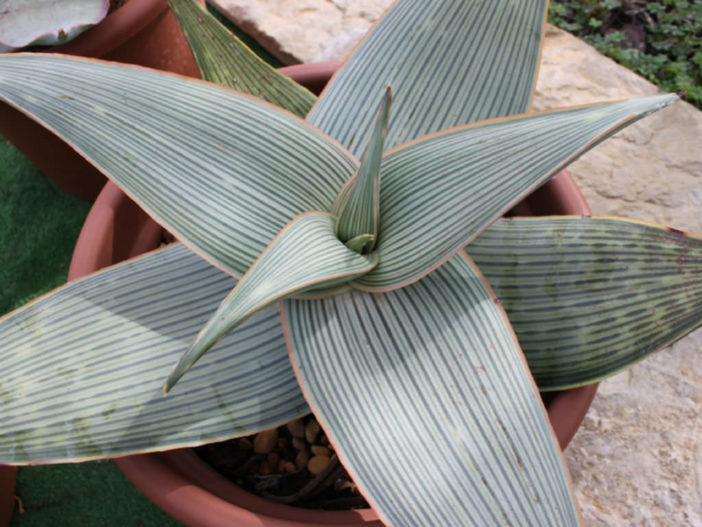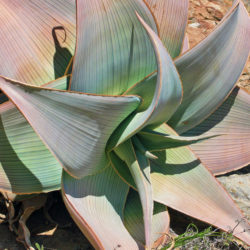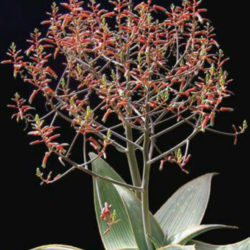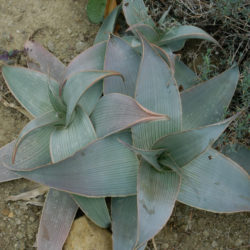Scientific Name
Aloe karasbergensis Pillans
Common Name(s)
Karasberg Aloe, Karasberg Coral Aloe
Synonym(s)
Aloe striata subsp. karasbergensis
Scientific Classification
Family: Asphodelaceae
Subfamily: Asphodeloideae
Genus: Aloe
Origin
This species is native to South Africa (Northern Cape) and southern Namibia.
Description
Aloe karasbergensis, also known as Aloe striata subsp. karasbergensis, is a low-growing succulent that forms beautiful rosettes of thick fleshy leaves with prominent dark green longitudinal lines. It usually grows solitary, but the older plants may produce up to 20 offsets around the base. The stems grow up to 12 inches (30 cm) long with persistent old leaves and tend to lie horizontally on the ground as the plant ages. Leaves are triangular, curved, up to 20 inches (50 cm) long, and up to 8 inches (20 cm) wide. The leaf color varies from pale gray-green to bronze and brown with a pinkish tinge when sun-stressed.
Flowers are carried on densely branched, up to 20 inches (50 cm) tall racemes and appear from mid to late winter. They are dull red and tubular with slight basal swelling.
Etymology
The specific epithet "karasbergensis (kar-as-berg-EN-sis)" refers to the Great Karas Mountains in southern Namibia, where the species was discovered by Neville Stuart Pillans, a botanist who added it to his Rosebank garden in Cape Town in the mid-1920s.

Hardiness
USDA hardiness zone 9a to 11b: from 20 °F (−6.7 °C) to 50 °F (+10 °C).
How to Grow and Care
Aloe is a very forgiving plant. However, as with all succulents, Aloe must never be allowed to sit in stagnant water, and the plant should be carefully monitored to watch for signs of overwatering. Water generously in the summer and nearly cease watering in the winter. Do not let water stand in the rosettes.
Aloes are not particularly fast-growing and will only rarely need repotting. Repot plants in the spring that are tipping over their pots or have ceased growing. Use a fast-draining potting mix with one-third of sand or pebbles. When repotting a larger plant, dividing the root ball carefully is possible. Some kinds of Aloe will send off offsets that can be potted independently.
See more at How to Grow and Care for Aloe.
Links
- Back to genus Aloe
- Succupedia: Browse succulents by Scientific Name, Common Name, Genus, Family, USDA Hardiness Zone, Origin, or cacti by Genus
Photo Gallery
Click on a photo to see a larger version.


